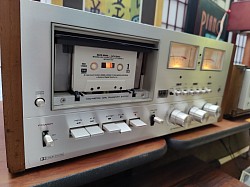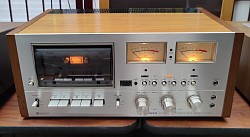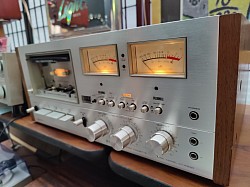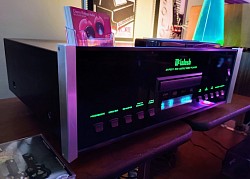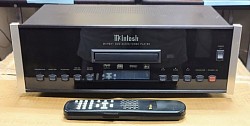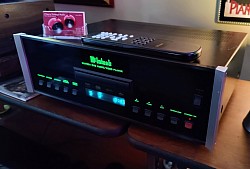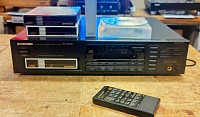Stereo Tape Decks / CD / Misc
Pioneer CT-F9191
stereo cassette deck ('75-'77) $1250 (fully restored, upgraded)
This beautiful Pioneer CT-F9191 stereo cassette deck is in excellent cosmetic and operating condition.
It was completely restored, upgraded and serviced in December 2024 as follows:
~All the belts have been replaced, all pulleys, wheels and mechanisms were cleaned and checked
~The C806, 807, 810 electrolytic capacitors were replaced with new caps to spec.
~The idler tire and tension spring were replaced.
~All the switches on the control board were cleaned and lubed with Deoxit Gold.
~The head and capstan were cleaned and demagnetized.
~The tape speed was adjusted (reading 62hz with 60hz tape)
~Verified meter adjustment and playback levels are in spec.
~All final performance checks and datalog sheets are include
The CT-F9191 was Pioneer's top of the line for this series and features one of the highest quality two-motor decks to come from Japan in the mid 70's. The overall design combined with it's large visual appearance has proven to be one of the most desirable cassette decks to come out of Japan in the 70's.
Thanks to the extensive servicing, all functions are working perfectly: The "Play" function is consistent, the fast forward / reverse functions are smooth and fast. The beautiful brushed aluminum faceplate is in good condition while the real walnut veneer case has small dings here and there. All lamps, meters, switches and controls are working perfectly.
From the Pioneer sales sheet:The Pioneer CT-F9191 is an advanced cassette tape deck of original design providing easy front panel operation.
The cassette installs vertically for fast, fumble free setting. Tape running at play and record speed is performed by a DC servo motor, while a high torque mechanical governor equipped motor drives fast forward and rewind. Precision design and finishing of the capstan, belt, flywheel and tape take up mechanism combine to offer outstanding wow and flutter characteristics and stability.
The desired transport mode: record or play, fast forward, rewind, can be directly switched without alternating with the stop switch. Perfect timing is provided by a semiconductor logic circuit which functions to protect the tape from damage.
Tape hiss can be significantly reduced (by approximately 10dB at high frequencies) without impairing the program source quality by the built in Dolby system.
The ferrite solid record/playback head resists abrasion and possesses numerous advantages which include long life, excellent high frequency response and head touch, plus reduced problems of dirt adhesion and magnetization noise.
3-stage direct coupled circuitry is employed in the equalizer and microphone amplifiers to provide excellent phase characteristics. Effective negative feedback is applied up to ultra high frequencies, assuring stable high frequency response and a dynamic margin exceeding 40dB of the base level.
+++++++++++++++++++++++++++++++++++++++
+++++++++++++++++++++++++++++++++++++++
McIntosh MVP851
CD/DVD player ('07-'10) $1100 (perfect)
First obtained from the original owner and in mint condition, this fully operational McIntosh MVP851 CD/DVD player also comes with the original McIntosh HR040 remote control. The owner's manual is also included.
Selling for a hefty $3600 upon its initial release in 2007, the MVP851 was not McIntosh's first CD/DVD to hit the market. It was, however, their first DVD-A player.
(NOTE: Commonly abbreviated as DVD-A, it's actually called DVD-Audio. It's a digital format for delivering high fidelity audio content on a DVD. DVD-Audio uses most of the storage on the disc for high-quality audio and is not intended to be a video delivery format.)
Like the many McIntosh components before it, the MVP851's front panel is that familiar and hypnotic shiny black glass face with green backlit label (this classic design looks just as elegant as it did when first introduced in the "olden days" of the late 50's.
In a nutshell, the MVP851 features high resolution video processing, progressive scan video output, 192kHz/24 bit audio decoding and multi-channel audio formats, including the aforementioned DVD-Audio.
But, rather than attempt a lengthy description of this amazing unit, here's a link to the best in-depth coverage: https://www.soundandvision.com/content/mcintosh-mvp851-dvd-audiovideo-player
Essential specs:
~24/192 Audio DACs
~12 Bit Video DACs
~Progressive Scan
~XLR Audio Out for Front Channels
~Heavy Steel Chassis
~Dimensions: (Front Panel) 17.5" wide x 5.5" (the depth behind the front mounting panel is 15" including clearance for connectors. The panel clearance required in front of the mounting panel is 3/4".
NOTE: When the DVD/CD tray is opened, the panel clearance required in front of the mounting panel is 6.75")
~Weight: 20 pounds
+++++++++++++++++++++++++++++++++++++++++++
+++++++++++++++++++++++++++++++++++++++++++
Pioneer PD-M435
Multi-Play CD Player (1990) SOLD
In excellent cosmetic and operating condition, this Pioneer PD-M435 is a 6-disc Multi-Play CD Player. This versatile unit offers convenient playback of up to 6 CDs contained in user-friendly interchangeable cartridges. It comes with four cartridges and the original Pioneer remote control.
Key features and specs:
6-disc magazine (cartridge) for extended listening sessions
High-quality LC78820 digital converter for pristine sound reproduction
PEA1030 CD mechanism ensures smooth and reliable disc reading
Impressive frequency response of 2Hz to 20kHz for full-spectrum audio
Excellent dynamic range of 92dB for lifelike sound
Outstanding signal-to-noise ratio of 106dB for crystal-clear playback
Minimal THD of just 0.04%
2V line output for compatibility with various audio systems
Dimensions: 16.5"W x 12.8"D x 4"H
Original Pioneer factory remote control
+++++++++++++++++++++++++++++++++++++++++++++
+++++++++++++++++++++++++++++++++++++++++++++
